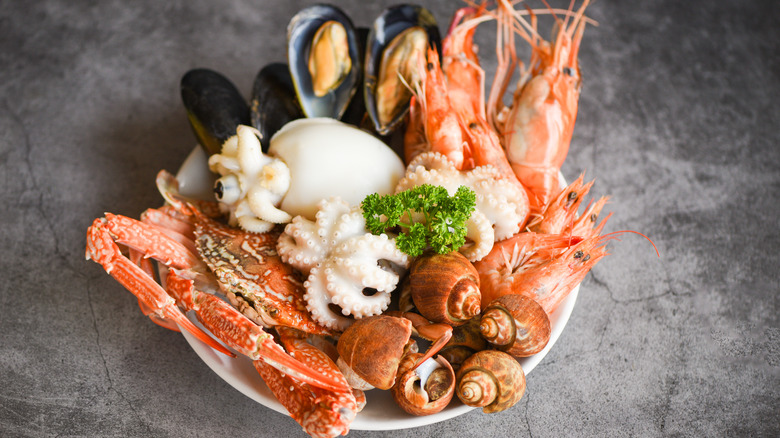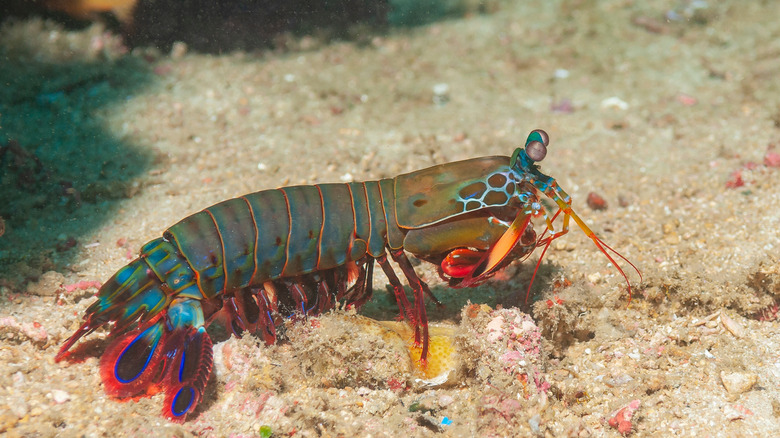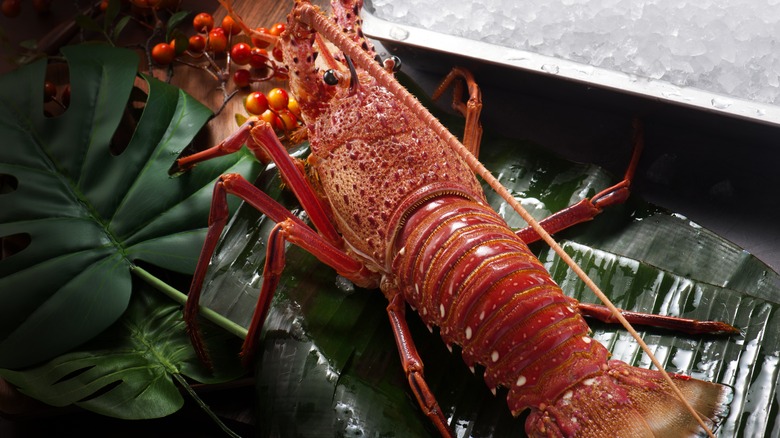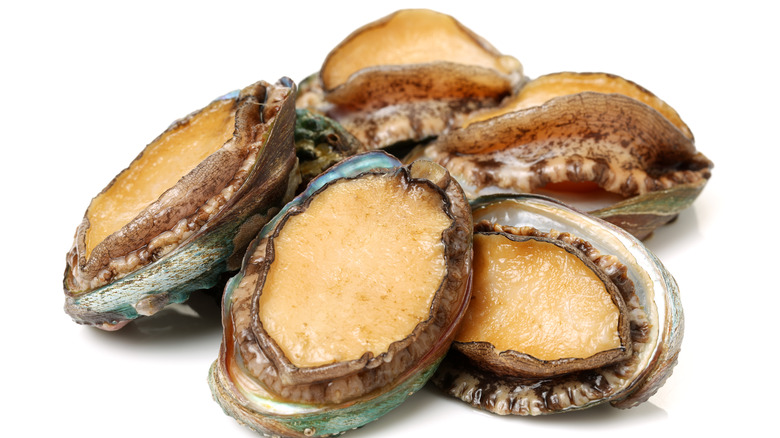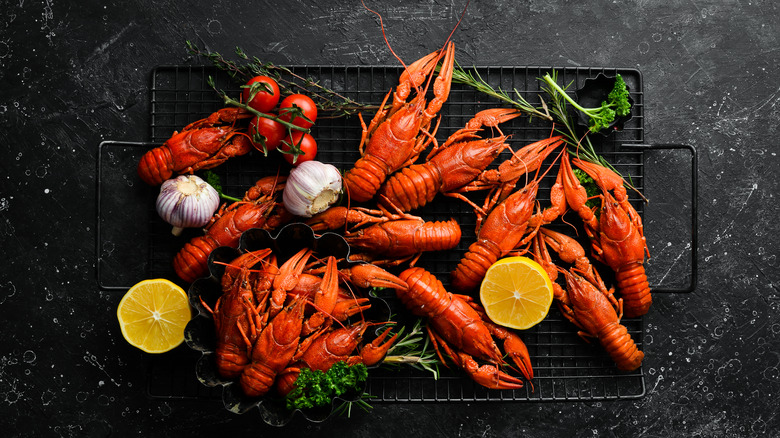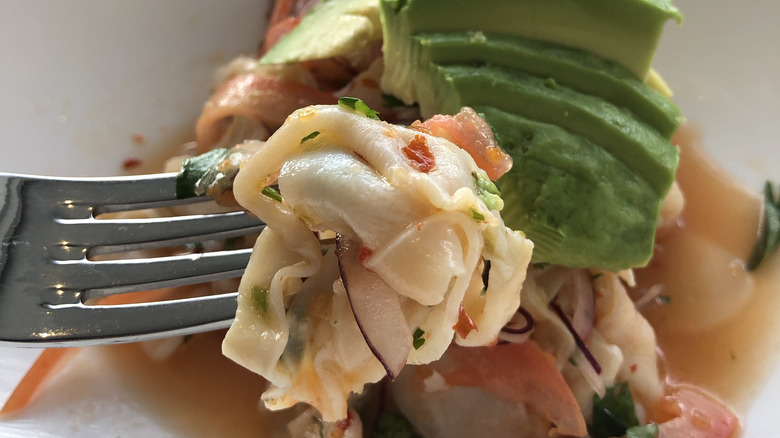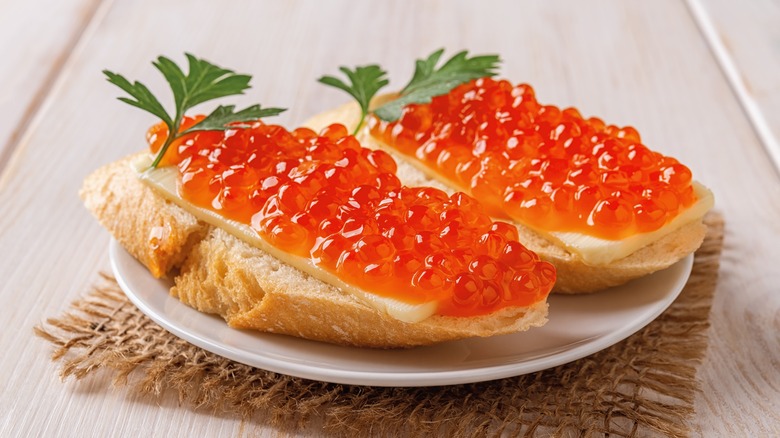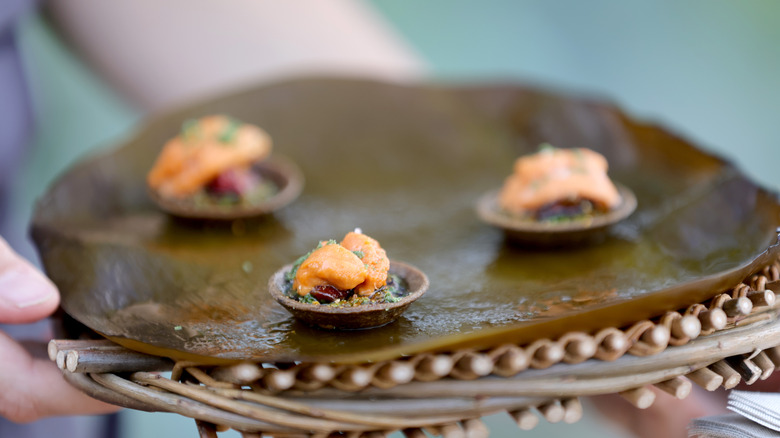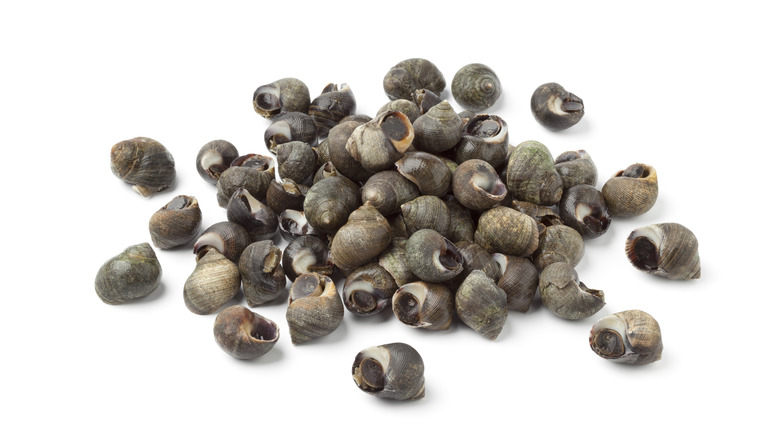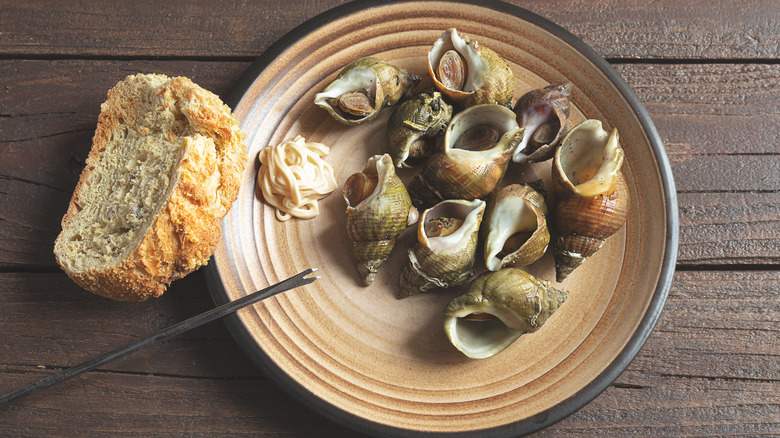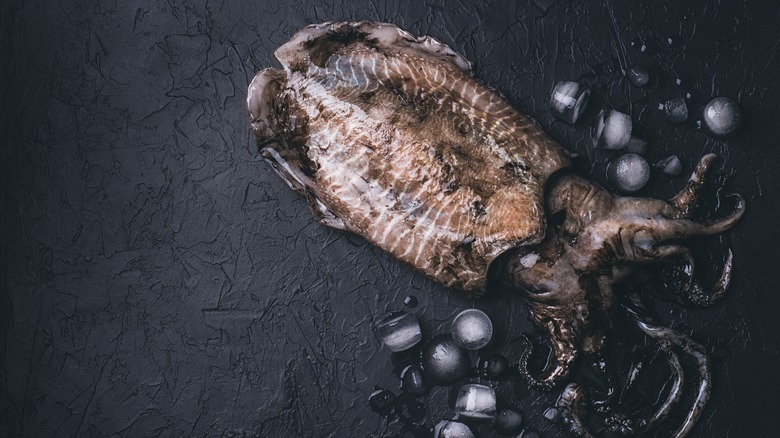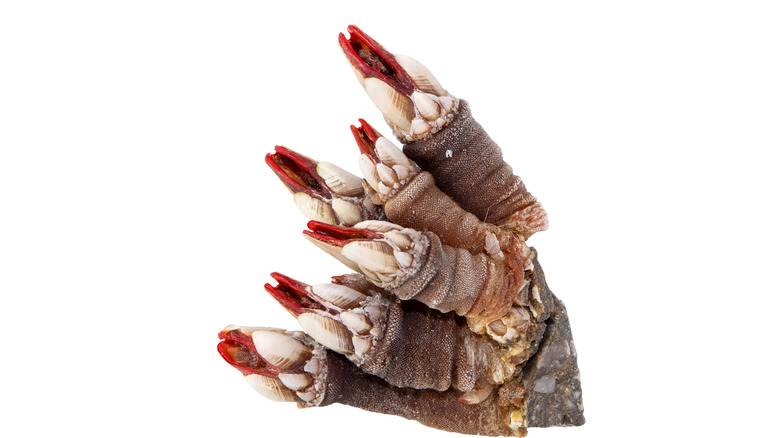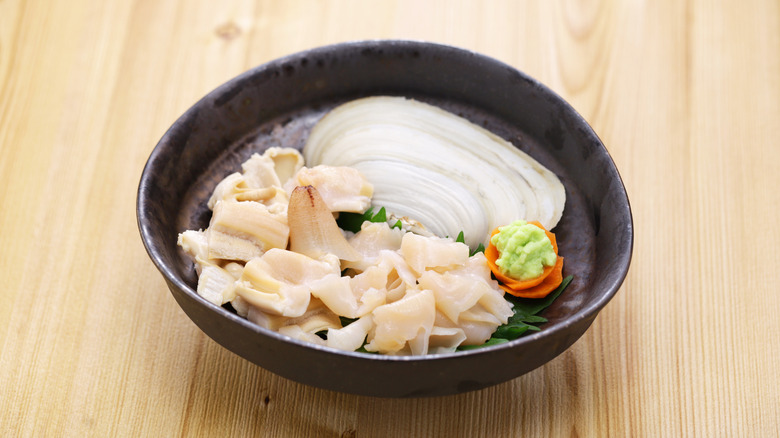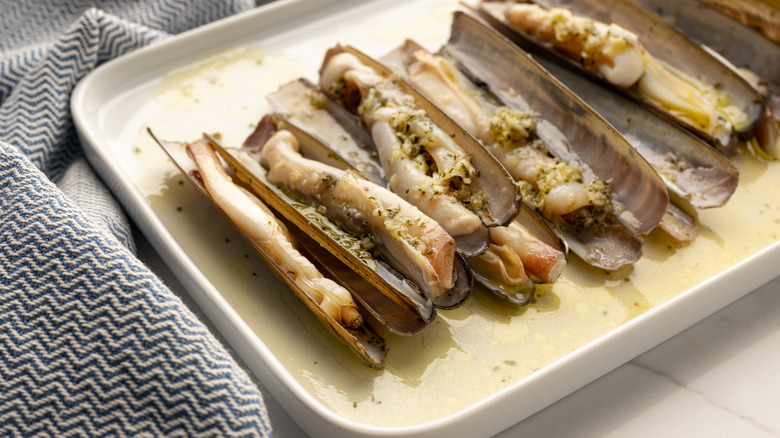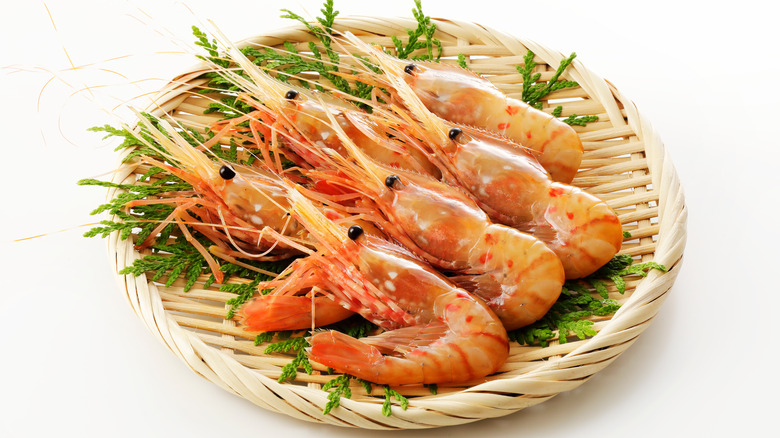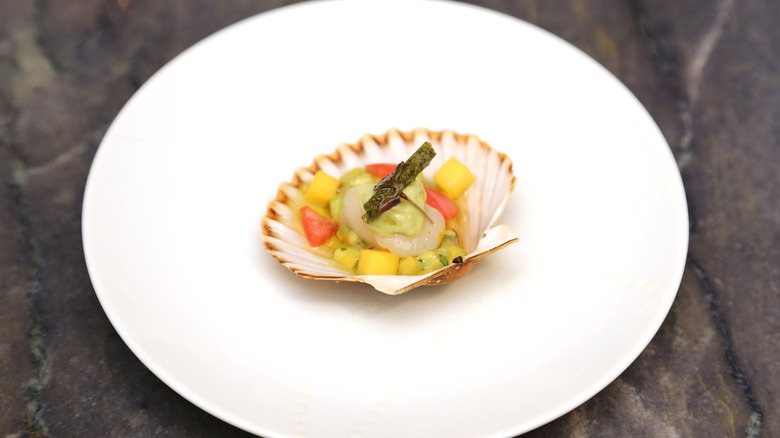15 Types Of Seafood You Need To Stop Overlooking
When it comes to seafood, some love it and some hate it, and there is rarely an in-between. You can think of seafood as an acquired taste because it takes some time to get used to the various textures and flavors of the creatures that inhabit the sea. And shellfish seem to be even more of an acquired taste than regular fish.
According to Healthline, seafood, particularly shellfish, has many health benefits, as it is rich in protein, healthy fats, and minerals. For example, shellfish have omega-3 fatty acids, iron, zinc, magnesium, and vitamin B12, which can improve health. When most people think of non-fish seafood, shrimp, crab, and lobster come to mind. But the seas have much more to offer, and, surprisingly, those shellfish varieties you never thought could be edible prove to be the best-flavored and the most sustainable. So, just as you need to stop overlooking some fish varieties, you must also consider some new seafood varieties to expand your culinary horizon and learn more environmentally friendly eating habits. Take a look at the following seafood types and let them inspire you in your cooking.
Mantis shrimp
If you're ever in a fish and seafood market and find a large creature that looks like an oversized shrimp covered in a thick, colored outer shell, don't avoid it. It's mantis shrimp, a crustacean that lives in the ocean and is classified as a predator. This shrimp variety has a distinctive look with its bright colors and sharp claws. It can be found in many places worldwide, including countries like China and Japan, as well as throughout Southeast Asia. You can sometimes find it in seafood markets, but many people avoid it because of its striking aspect. Nevertheless, Mantis shrimp is popularly eaten in some parts of Asia as a delicacy. It is often boiled and served as part of various cuisines or used as a sushi topping.
Mantis shrimp has sweet and tender meat, similar to lobster but with an even more intense flavor. It also packs a lot of meat, as it's much larger than regular shrimp. As a result, its taste resembles crab meat or even scallops. To cook mantis shrimp, clean and prepare it by removing the shell and any unwanted parts. Then, heat a pan with oil, garlic, and your desired seasoning. Once hot, add the mantis shrimp and cook for a few minutes until it turns a reddish color. You can also try boiling it, roasting it, or preparing it with garlic and chili, as many Asian cuisines do. Just be careful, because taking it out of the shell is a little challenging.
Spiny lobster
A lobster has claws, right? As much as this statement seems true, it's not always the case. Spiny lobster is a crustacean found in the Caribbean, off the shores of South America, and across the Indo-Pacific ocean. It has no claws but two long antennae used for defense. Furthermore, spiny lobsters contain more meat and less sweet flavor than the Maine lobster species. However, they come with a unique, nutty flavor and a deep, complex texture, which can be described as both chewy and creamy.
Due to its high demand in Asia, spiny lobsters are commonly shipped to China for consumption. However, you can find it in California and Florida and online, sold by producers focusing on homegrown seafood. With its flavor that resembles crawfish, spiny lobster works in many dishes, from mac and cheese to omelet and gumbo. To enjoy its pure taste, boil the tail and grill it for a few minutes. Spiny lobster is also great in ceviche and tacos.
Abalone
Abalone is a type of sea snail that was once well-known in the U.S., but nowadays, it's harder to find because of its popularity in the Asian market. Still, there are some farms where you can find them. With a beautiful and distinctive shell, abalone is highly prized as both an ingredient and an edible delicacy and can be found in many cuisines worldwide. Abalone has a sweet, delicate, salty-sweet flavor and firm texture, making it perfect for many dishes. Its texture is similar to that of scallops but with a firmer bite. When cooked properly, abalone can be incredibly tender and succulent.
There are many ways to enjoy abalone, from steaming or boiling in soup to grilling or sautéing in butter. In some Asian cuisines, it is served raw as sushi or sashimi, while Western chefs may prepare it grilled or breaded and fried. Limpets, a cheaper sea snail option similar to abalone, are usually grilled and served with a butter-garlic dressing, bringing out their natural salty and sweet taste.
Crayfish
Crayfish, also called crawfish or crawdads, are freshwater crustaceans related to lobsters and shrimp. Native to North America and Europe, they can be found in lakes, streams, and rivers. Crayfish have a mild seafood flavor and a delicate texture when cooked. Louisiana is especially famous for its crayfish boils, where the crustaceans are cooked in a spicy broth with potatoes, other vegetables, and sometimes other types of meat.
Eating crayfish requires some technique, as it can be tricky to get at all their meat. It's a process that's quite messy but ultimately worth it because of crayfish's delicate and unique taste. The best way is to twist off the tail from the body and suck out the meat from the inside. Then, you can peel off the tail's thin shell for even more deliciousness. The claws of larger crayfish can also be cracked open for more flavorful bits of flesh.
Sea conch
Sea conch is a variety of sea snails found in the Bahamas, Turks and Caicos, and Jamaica. In the U.S., you can usually find canned or frozen sea conch that can be used in various recipes. While they are most commonly found in shallow waters, they can also live in deeper waters. These snails are around three inches long, and their shells are usually cream or light brown.
Eating sea conch can be a delicious and nutritious experience, but it requires some preparation to enjoy it properly. First, ensure that the conch is fresh and properly cleaned. Next, soak the conch in cold water for several hours and scrub the shell and meat with a brush to remove any dirt or debris. Once clean, cook the conch by boiling or steaming it until the meat is tender. Then, slice or chop the meat and season it with salt, pepper, lime juice, and other spices to taste. Sea conch can be served in salads, stews, sushi, ceviche, soups, or as a stand-alone dish, and it pairs well with various vegetables and grains. The most appreciated cooking method is boiling the meat with garlic, onions, oregano, or thyme. They have a firm texture when raw but become tender when cooked. The flavor is mild but slightly sweet, with hints of saltiness from the seawater.
Roe
Have you ever wondered about the tiny red spheres you can sometimes find on top of sushi? They are roe, a type of fish egg, often from salmon, that is eaten as a delicacy worldwide. It can be found in various forms, including fresh, canned, and frozen. Each type has its distinct flavor and texture that can range from salty to sweet and crunchy to soft. Roe can be used as an ingredient in many dishes or enjoyed as a snack, and is also popularly used to garnish sushi and sashimi.
Roe comes in two main types: red and black roe. Red roe is typically harvested from salmon and trout, while black roe comes from other species, such as carp or cod. Both types have unique flavors and textures that vary depending on the particular fish species from which they are sourced.
A particular type of roe is caviar, a delicacy made from sturgeon roe. It has a robust, marine, and salty flavor and is traditionally paired with toast, blinis, butter, or cream cheese. Although caviar is notoriously expensive, today there are many varieties, some of which are more affordable. Among the most popular and affordable caviar varieties are salmon, trout, and lumpfish caviar.
Sea urchin
Sea urchin is considered a delicacy in Asian cooking and can be commonly found as a sushi component. Sometimes, you can locate sea urchins in seafood markets. As unlikely as it may seem, sea urchin is edible and actually quite tasty. It has a unique flavor and texture that make it a popular delicacy.
The most challenging part about eating sea urchin is removing it from its hard shell and carefully extracting the body parts. The most popular way to eat sea urchin is raw on top of sushi or sashimi, but you can also sprinkle it with lemon juice and serve it with salty crackers. It has a creamy texture with hints of sweetness and brine, which can be quite pleasant to the palate. Sea urchin also goes well with other ingredients, such as soy sauce and wasabi, for added flavor. It's also great when added to other seafood dishes, such as seafood paella or seafood risotto. It adds an interesting flavor profile to any dish due to its briny taste.
Winkle
Winkle is a type of small sea snail found in the shallow waters of the Atlantic and Pacific Oceans. It is one of the most popular delicacies in many cultures worldwide and has been enjoyed for centuries. In the United States, winkle can be found in seafood markets and restaurants.
Winkle's unique flavor and texture make it an interesting dish to try. Its flavor is sweet yet briny with a buttery texture. In addition, the soft inner body has a mild taste that can be easily paired with other ingredients. Cooking winkles requires patience and technique due to their small size; however, they can be cooked deliciously once mastered. Rinse the winkles in fresh water to ensure they are clean and leave them to soak for a few hours. Then boil the winkles or steam them with aromatic herbs such as a bay leaf or thyme-infused water to enhance their flavor. Additionally, winkle can also be cooked with traditional recipes such as paella or stews.
Whelk
Whelk is an edible sea snail commonly consumed in many parts of the world, particularly in Asia and Europe. It has a unique flavor and texture, making it a popular dish for seafood lovers. In the United States, whelk can be found in specialty stores and online retailers.
The flavor of whelk is slightly sweet with a hint of saltiness, similar to clams or mussels. The texture can be chewy or crunchy, depending on how it is cooked. Boil whelk for at least 10 minutes and then serve it whole or cut it into thin slices for added flavor. Several New York chefs serve whelk in their restaurants, pairing it with garlic sauce or making it a chowder ingredient.
Apart from the Atlantic whelk, there are other species, such as the Black Sea whelk. These sea snails are smaller but have similar texture and taste. They are mostly consumed pan-grilled, stewed, or marinated and offer an enjoyable, chewy texture, similar to squid, and a sweet and salty taste.
Cuttlefish
Cuttlefish is a type of seafood that is quite popular in Europe and Asia. It has a mild flavor and delicate texture, making it an excellent addition to many dishes. Cuttlefish are typically found in shallow, coastal waters around the United States and can be cooked in several different ways.
Cuttlefish are cephalopods with soft bodies and two long tentacles with an array of suction cups for catching prey. In addition, they have an oval-shaped shell called a cuttlebone. The color of cuttlefish ranges from light brown to dark brown, making them easy to spot when diving or fishing.
One of the most common ways to cook cuttlefish is by frying or baking it with garlic, onion, and other herbs and spices. This method brings out the sweetness of its flesh while still preserving its delicate texture. Cuttlefish can also be added to soups or eaten as part of a risotto variety prepared in the Balkans called crni rižot (a Croatian dish).
Barnacles
Barnacles are popular seafood in the Iberian Peninsula and are slowly gaining popularity in the U.S. They are a type of shellfish related to crabs and lobsters. Barnacles thrive in saltwater and freshwater worldwide and have been an important food source for many coastal cultures, including Northern Europe, New England, China, and Japan.
Their odd exterior (they resemble dinosaur toes) is counterbalanced by the softness of the flesh and the briny taste reminiscent of the ocean. They usually grow in shallow and cold water, preferably on rocky shorelines. They are available in Basque restaurants, and part of the Japanese groceries offer.
Barnacles have a unique taste that is both sweet and salty, with a slightly sour aftertaste. The texture is similar to other shellfish, with a slightly crunchy bite when cooked or steamed. Barnacles can be prepared in various ways, such as boiling, steaming, baking, or deep-frying. They make an excellent appetizer or side dish to any meal when properly cooked. For those who like seafood but don't want to deal with the hassle of shelling them before cooking, barnacles offer an easy way to enjoy some delicious shellfish without all the fuss.
Geoduck
Geoduck is a unique shellfish popular in many parts of the world, particularly in Asia. You can find geoduck in the Northwestern parts of the U.S. and Canada, but it's not extremely popular. It has an unusual look that makes it stand out from other seafood, and its taste and texture make it a favorite among seafood lovers.
Geoducks are large saltwater clams found in the Pacific Northwest. They have long necks and large shells with an orange-brown color, and their meat has a mild, sweet flavor and crunchy texture. It can be eaten raw (cleaned and blanched) or cooked in various dishes like salads, soups, steamed dishes, and more. It makes excellent sashimi, but it's also delicious in chowder or ceviche.
When cooking geoduck, it's important to note that its flavor intensifies because of its high protein content. Therefore, it's best to cook it briefly, no more than two minutes, to maintain its taste and texture. Geoducks can also be grilled or roasted, so make sure not to overcook them, as they can become chewy.
Razor clams
Razor clams are a popular and delicious seafood delicacy found along the coastlines of many countries. In the U.S., they can be found along the Pacific coastline. These long and narrow bivalves are prized for their tender, sweet flesh and are a favorite among seafood lovers. You can find them in shallow waters and on sandy beaches.
To prepare razor clams for cooking, start by cleaning them thoroughly. Be careful not to crack the shell, as it is very brittle. Soak them in salt water for at least 30 minutes to help remove any sand or grit that may be present inside the shell. Then, rinse them under running water and pat them dry with a paper towel. For steaming, place the cleaned razor clams in a steamer basket and set the basket over a pot of boiling water. Cover the pot and let the clams steam for five to seven minutes until they open. Remove the clams from the steamer and serve immediately with a squeeze of fresh lemon juice. You can also grill and serve them with garlic butter or a drizzle of balsamic vinegar.
Spot prawns
Spot prawns are a type of shrimp considered a delicacy due to their short availability window, tender texture, and great flavor. They are popular in Southern California and British Columbia but can be delivered nationwide. Spot prawns have a red-brown color and distinctive white spots, and they are best when bought fresh. They should be translucent and present a firm texture, with no soft or mushy parts.
You can enjoy spot prawns in several ways. First, you can try them as sashimi, seasoned with soy or ponzu sauce. (Don't discard the shells, though, as they make an outstanding stock or bisque.) You can also use spot prawns for making ceviche. Mix lime, orange, and lemon juice and soak the diced prawns in this juice until they reach the desired texture. You can also steam spot prawns, sauté them or poach them. They taste great when paired with butter, lemon juice, coconut milk, lemongrass, ginger, and vinegar.
Bay scallops
Bay scallops are a popular seafood delicacy found in waters along the East Coast of the United States and Canada. These small, sweet scallops are highly prized for their tender, succulent meat, and delicate, salty flavor. Bay scallops are generally smaller than their larger, meatier cousin, the sea scallop, and they are typically found in shallower waters near the shore.
The texture of bay scallops is soft and tender, with a slight chew that seafood enthusiasts prize. Their flavor is mild and somewhat sweet, with a subtle saltiness enhanced by their proximity to the ocean. It is important not to overcook bay scallops, as they can quickly become tough and rubbery. They are best cooked quickly, either by pan-searing, sautéing, or poaching, and served with a light sauce or garnish that complements their delicate flavor. Bay scallops can also be grilled, broiled, or baked, depending on the recipe and desired texture.
